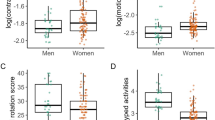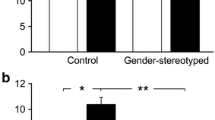Abstract
At an early age, children attain concepts of sex-appropriate activities, behaviors, attitudes, and goals, i.e., sex-role stereotypes. These conceptual stereotypes seem to assign a less favorable role to females. Thus it seems plausible that their acceptance (by both sexes) might be at least partly responsible for the performance differences that begin to arise in adolescence and adulthood. In view of the importance of early adolescence as a transitional period during which sex-role requirements are augmented and intellectual sex differences emerge, 105 11-year-olds and 102 14-year-olds were selected as subjects. Their spatial abilities, sex-role concepts, and sex-role preferences were assessed. Stereotyping sex roles (in general) was not associated with spatial performance; stereotyping sex roles that included information regarding subjects' views about intellectual competence was related to performance. The sex difference in spatial ability that emerged at age 14 was among subjects with own-sex preferences only; there were no sex differences among subjects who preferred to be boys.
Similar content being viewed by others
References
Barron, F. Originality in relation to personality and intellect. Journal of Personality, 1957, 25, 730–742.
Bennett, Seashore, & Wesman. 1947.
Bieri, J. Parental identification, acceptance of authority, and within-sex differences in cognitive behavior. Journal of Abnormal Social Psychology, 1960, 60, 76–79.
Broverman, I. K., Broverman, D. M., Clarkson, F. E., Rosenkrantz, P. S., & Vogel, S. R. Sex-role stereotypes and clinical judgments of mental health. Journal of Consulting Clinical Psychology, 1970, 34, 1–7.
Brown, D. G. Sex-role preference in young children. Psychological Monographs, 1956, 70, No. 14.
Brown, R. Social Psychology. New York: Free Press, 1965.
Dwyer, C. A. Children's sex role standards and sex role identification and their relationship to achievement. Doctoral dissertation, University of California at Berkeley, 1973.
Ellis, L. J., & Bentler, P. M. Traditional sex-determined role standards and sex stereotypes. Journal of Personality and Social Psychology, 1973, 25, 28–34.
Faris, R. E. L. Social psychology. New York: Ronald, 1952.
Hartley, R. E., & Hardesty, F. P. Children's perceptions of sex roles in childhood. Journal of Genetic Psychology, 1964, 105, 43–51.
Kagan, J. Acquisition and significance of sex typing and sex role identity. In M. Hoffman & L. Hoffman (Eds.), Review of child development research, Volume 1. New York: Russell Sage, 1964.
Kagan, J., & Moss, H. A. Birth to maturity. New York: John Wiley & Sons, 1962.
Maccoby, E. E. Woman's intellect. In S. M. Farber & R. L. Wilson (Eds.), The potential of woman. New York: McGraw-Hill, 1963.
Maccoby, E. E. Sex differences in intellectual functioning. In E. E. Maccoby (Ed.), The development of sex-differences. Stanford: Stanford University Press, 1966.
Maccoby, E. E., & Jacklin, C. N. Sex differences in intellectual functioning. Paper presented at the Invitational Conference on Testing Problems — Assessment in a Pluralistic Society, 1972.
Maccoby, E. E., & Jacklin, C. N. The psychology of sex differences. Stanford: Stanford University Press, 1974.
MacKinnon, D. W. The nature and nurture of creative talent. American Psychologist, 1962, 17, 484–495.
Mead, M. Sex and temperament. New York: Morrow, 1935.
Milton, G. A. The effects of sex-role identification upon problem-solving skill. Journal of Abnormal and Social Psychology, 1957, 55, 208–212.
Mussen, P. H. & Rutherford, E. Parent-child relations and parental personality in relation to young children's sex-role preferences. Child Development, 1963, 34, 589–607.
Oetzel, R. The relationship between sex role acceptance and cognitive abilities. Unpublished master's thesis, Stanford University, 1961.
Seward, G. H., & Larson, W. R. Adolescent concepts of social sex roles in the United States and the two Germanies. Human Development, 1968, 11, 217–248.
Smith, S. Age and sex differences in children's opinion concerning sex differences. Journal of Genetic Psychology, 1939, 54, 17–25.
Stein, A. H., & Smithells, J. Age and sex differences in children's sex-role standards about achievement. Developmental Psychology, 1969, 1, 252–259,
Vener, A. M., & Snyder, C. C. The preschool child's awareness and anticipation of adult sex roles. Sociometry, 1966, 29, 159–168.
Wylie, personal communication. 1973.
Author information
Authors and Affiliations
Additional information
This article is based upon a doctoral dissertation presented to the Department of Psychology of Columbia University. The author would like to express her thanks to her advisers, Phillip Shaver and Deanna Kuhn; to her committee members, Robert Krauss, Norma Graham, Patrick Lee, and Wayne Proudfoot; to Carol Jacklin and Ruth Wylie for their advice and support; and to Flora Churnin, Douglas Churnin, and Carl Nash for their invaluable assistance during all phases of this study.
Rights and permissions
About this article
Cite this article
Nash, S.C. The relationship among sex-role stereotyping, sex-role preference, and the sex difference in spatial visualization. Sex Roles 1, 15–32 (1975). https://doi.org/10.1007/BF00287210
Issue Date:
DOI: https://doi.org/10.1007/BF00287210




